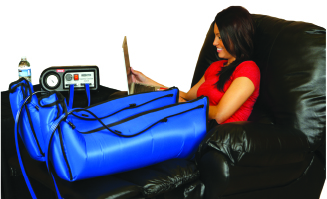By Alyssa Parker
 Pneumatic compression devices are one of the most highly recommended treatments for limb swelling and are a Medicare Medicare approved treatment option. Dating back to the 1960’s pneumatic compression pumps have been used for the treatment of limb swelling due to acute and chronic conditions. In most cases compression pumps are used for swelling associated with lymphedema as well as venous insufficiency. Limb swelling left untreated without a clinical diagnosis and lack of proper treatment may lead to a variety of problems.
Pneumatic compression devices are one of the most highly recommended treatments for limb swelling and are a Medicare Medicare approved treatment option. Dating back to the 1960’s pneumatic compression pumps have been used for the treatment of limb swelling due to acute and chronic conditions. In most cases compression pumps are used for swelling associated with lymphedema as well as venous insufficiency. Limb swelling left untreated without a clinical diagnosis and lack of proper treatment may lead to a variety of problems.
Patient’s with Venous Insufficiency who experience severe and persistent edema overtime can lead to trapped protein-rich fluid also referred to as secondary lymphedema. The lower region of the leg becomes permanently swollen and may start to harden. Due to poor circulation and protein-rich fluid buildup wounds may become chronic and appear more frequently. Common signs and symptoms that occur are fluid accumulation in a limb, a feeling of heaviness or tightness, thickening of the skin, pain or redness, or chronic ulcers in the affected limb.
How does compression therapy work?
A compression device is used for both acute care (short term in the hospital) as well as chronic care (long term in the home). The compression pump increases bloood flow and lymphatic flow. By increasing the circulation in the affected limb many painful symptoms will be alleviated. When compression treatment is used on a limb the excess fluid is removed and worked back into the lymphatic system the natural way. For patients with chronic ulcers using a compression device will help heal the wound from the inside out, by increasing the circulation in the return of the blood from the heart. The heart delivers oxygen rich blood back to the legs and the tissue.
The pneumatic sequential compression relieves the pain and pressure in the swollen area and reduces the size of the limb. The sequential inflation of the chambers, of the sleeve around the affected limb, begins distal (lower region of the limb furthest from attachment) to proximal (area of attachment to the body) naturally mimicking your bodies lymph return while stimulating the blood flow in the legs.
What causes limb swelling?
There can be many different causes for limb swelling, however, two of the most common diseases for chronic limb swelling are Lymphedema and Venous insufficiency. After having a surgical procedure cancer or non-cancer related (example hysterectomy or gallbladder removal) it may take months or years for Lymphedema to manifest because of its slow progression. It is imperative that Lymphedema is treated quick and effectively, regardless of the severity. Complications dramatically decrease when treatment is started in the earliest stage of Lymphedema.
Chronic venous insufficiency is another condition that causes swelling in the legs along with open wounds. CVI occurs when the valves in the veins that normally channel the blood to the heart become damaged which then leads to pooling of the blood in the lower extremities.
Discoloration of the skin, referred to as hemosiderin staining, is identified by a reddish staining of the lower limb. Poor circulation my cause shallow wounds to develop due to the stagnant blood that would normally return to the heart. Symptoms vary but may include swelling, aching, itching or burning, varicose veins, infection, chronic venous ulcer, and decreased mobility.
Is a Compression Device the right treatment for me? Using a compression device is a great treatment option for patients who have tried compression stocking, elevation, diuretics, and massage with little or no relief. It’s also a treatment option for individuals who have chronic venous ulcers. When compression stockings get worn out or stretched over time; many patients aren’t receiving the needed compression. When using a compression pump the pressure is locked in, ensuring that you’re getting the appropriate amount of pressure each treatment.
Diuretics may be useless and harmful over time if your edema (swelling) is a symptom of chronic venous insufficiency or lymphedema. Diuretics draw fluid from your venous system that your body must have in order to balance the continual fluid deposit from your arterial capillaries; if the needed interstitial fluid is not present because you are taking a diuretic, this will only aggravate your lymphatic system which may lead to additional fluid retention and additional swelling. Also, using a pneumatic compression device may help the prevention of blood clotting along with deep vein thrombosis or those individuals who are at risk for it.
If you or someone you love suffers from limb swelling it is important to keep a few things in mind. If any of the following apply, seeking medical advice is recommended.
• Family history of edema, venous insufficiency, or lymphedema
• Pitting or skin hardening: push your finger into your skin and count how long it takes to return
• Hemosiderin staining: “red socks” appear from the ankles down
• Traumatic injury or surgery potentially damaging your circulatory system (knee replacement etc.)
• Radiation exposure
For patients who many have Chronic venous insufficiency a test called a vascular or duplex ultrasound may be used to examine the blood circulation in your legs.
The compression pump is approved by Medicare and covered by many commercial insurers; Actual coverage varies with individual commercial insurance policies. Acute Wound Care, LLC is a highly focused local provider of wound products and compression pumps working with select area physicians highly versed in this condition.
ACUTE WOUND CARE
For more information and articles on this topic, Google “Acute Wound Care” or visit www.AcuteWoundCare.com or call and speak with a specialist.
toll free 855-949-4325(HEAL)
Check Also
Trusted Homecare Agency: Serving Veterans with Free Supplemental Home Healthcare
When it comes to healthcare, veterans deserve the best care possible. For veterans seeking in-home …
 South Florida Health and Wellness Magazine Health and Wellness Articles
South Florida Health and Wellness Magazine Health and Wellness Articles




